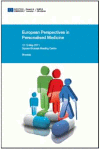Predictive, Preventive and Personalised Medicine as the hardcore of 'Horizon 2020': EPMA position paper
- PMID: 24708704
- PMCID: PMC3985551
- DOI: 10.1186/1878-5085-5-6
Predictive, Preventive and Personalised Medicine as the hardcore of 'Horizon 2020': EPMA position paper
Abstract
The European Association for Predictive, Preventive and Personalised Medicine (EPMA) considers acute problems in medical sciences as well as the quality and management of medical services challenging health care systems in Europe and worldwide. This actuality has motivated the representatives of EPMA to comment on the efforts in promoting an integrative approach based on multidisciplinary expertise to advance health care-related research and management. The current paper provides a global overview of the problems related to medical services: pandemic scenario in the progression of common non-communicable diseases, delayed interventional approaches of reactive medicine, poor economy of health care systems, lack of specialised educational programmes, problematic ethical aspects of several treatments as well as inadequate communication among professional groups and policymakers. In the form of individual paragraphs, the article presents a consolidated position of PPPM professionals towards the new European programme 'Horizon 2020' providing the long-lasting instruments for scientific and technological progress in medical services and health care-related programmes. In the author's opinion, Horizon 2020 provides unlimited room for research and implementation in Predictive, Preventive and Personalised Medicine. However, the overall success of the programme strongly depends on the effective communication and consolidation of professionals relevant for PPPM as well as the communication quality with policymakers. Smart political decision is the prerequisite of the effective PPPM implementation in the health care sector. This position is focused on the patients' needs, innovative medical sciences, optimal health and disease management, expert recommendations for the relevant medical fields and optimal solutions which have a potential to advance health care services if the long-term strategies were to be effectively implemented as proposed here.
Figures

























References
-
- Advances in Predictive, Preventive and Personalised Medicine. [ http://www.springer.com/series/10051]
-
- Norstedt I. Horizon 2020: European perspectives in healthcare sciences and implementation. EPMA J. 2014;5:A1. doi: 10.1186/1878-5085-5-S1-A1. - DOI
LinkOut - more resources
Full Text Sources
Other Literature Sources

